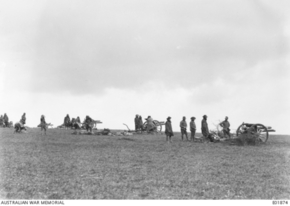
S2809
FAIRBAIRN, Edward George
| Service Numbers: | 2784, 36087 |
|---|---|
| Enlisted: | Not yet discovered |
| Last Rank: | Corporal |
| Last Unit: | Field Artillery Brigades |
| Born: | Camberwell, England, October 1892 |
| Home Town: | Not yet discovered |
| Schooling: | Not yet discovered |
| Occupation: | Marine Steward, Secretary |
| Died: | 2 April 1937, cause of death not yet discovered, place of death not yet discovered |
| Cemetery: | Not yet discovered |
| Memorials: |
World War 1 Service
| 20 Oct 1914: | Involvement Driver, 2784, Divisional Ammunition Column, --- :embarkation_roll: roll_number: '22' embarkation_place: Adelaide embarkation_ship: HMAT Medic embarkation_ship_number: A7 public_note: '' | |
|---|---|---|
| 20 Oct 1914: | Embarked Driver, 2784, Divisional Ammunition Column, HMAT Medic, Adelaide | |
| 9 Nov 1917: | Involvement Corporal, 36087, Field Artillery Brigades, --- :embarkation_roll: roll_number: '4' embarkation_place: Melbourne embarkation_ship: HMAT Port Sydney embarkation_ship_number: A15 public_note: Previously served as 2784, 2nd Divisional Artillery Column | |
| 9 Nov 1917: | Embarked Corporal, 36087, Field Artillery Brigades, HMAT Port Sydney, Melbourne | |
| 11 Nov 1918: | Involvement Corporal, 36087 |
Help us honour Edward George Fairbairn's service by contributing information, stories, and images so that they can be preserved for future generations.
Add my storyBiography contributed by St Ignatius' College
Biography of Edward George Fairbairn
Edward George Fairbairn was born in Camberwell, England on July 1893. He lived in the Parade, Norwood with his family, Mrs Mabel Jane Fairbairn. Edward had brown eyes, light brown hair, was 5 feet 10, and weighed 143 lbs, was single and was a secretary at the time.
Edward enlisted from a nominal roll for World War 1 at the age of 21 and 11 months young on the 30th of August 1914. He was allocated to be a driver (Divisional Ammunition Column) with a service number of 2784. Like other soldiers who were in the divisional ammunition column, he embarked on the HMAT Medic A7 in Adelaide on 20th of October 1914. The HMAT Medic A7 weighed 12,032 tons with an average cruise speed of 24.07 kmph.
In 19th Century warfare, artillery is a dominant component of military power. The effectiveness of artillery is very dominant, one reason is because of the range. Ammunition towards artillery was critical to sustain the effect. Edward was in an ammunition column in which there were many ways to transport the ammunition including motor, heavy and light rail, tramways and horses. Edward had to ride horses. He most likely was in charge and took responsibility for two horses. Horse transport with ammunition is a very risky job. Horses were very vulnerable to weapons and a hit would most likely kill them. Many people were killed in this process but Edward survived.
After a year of being an ammunition driver, Edward discharged on the 9th of November 1915 as his services were no longer needed. On the 7th of November 1916, (a year later), he enlisted in field artillery brigade. A year after enlisting, he was put into the 8th brigade and went to Victoria in Melbourne where many other soldiers were waiting and embarked the HMAT A15 Port Sydney on the 9th November, 1917 for artillery.
The HMAT A15 Port Sydney which was called Star of England weighing around 9,136 tons with an average speed of 25.00 kmph. He went to Suez on the 12th of December, (34 days after embarking) and went onto a ship in Alexandria like many other soldiers. The ship travelled to Southampton (in the UK) on the 4th of January 1918 (which took roughly 18 days), meaning he spent Christmas and new years on the ship. The ship then proceeded overseas from Southampton to Heytesbury (in France), on the 8th of April 1918.
The 8th field artillery brigade was formed in Egypt. Artillery inflicted the most damage and destroyed the terrain. Artillery’s effects were both physically and mentally damaging as many people called it ‘shell shock’. The field artillery brigades was formed to support infantry brigades. If you were working in artillery you would need to calculate the precise location of where you would want to fire or else things can go wrong and you can kill your own teammates known as friendly fire. The artilleries had a range of up to 6 kilometres. Edward was wounded on the 24th of April, possible because the artillery was faulty.
Edward returned home on 22nd of August, 1919 and discharged on the 5th of November 1919. He was awarded the British war medal, victory medal which wasn’t anything special as it was very common. Edward unfortunately died on the 2nd of April 1937 and was 44 years old at the time, which was young.
Edward showed the ANZAC spirit by going to war. He fought in long and risky battles which could’ve been fatal but he did it for his country which shows loyalty and bravery. He rode on horses and made them push ammunition which would’ve been hard to look at (animal abuse), but he dealt with it. He discharged from driving and enlisted in artillery embarking on many ships to get there even though he experienced the horrible atmosphere of war, this shows courage.
Biography
Next of Kin: Mother, Mrs M Fairbairn, 109 Tottenham Road, Islington, London, England













